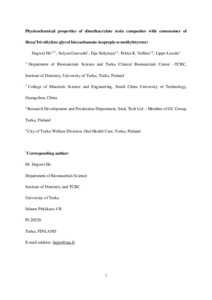Physicochemical properties of dimethacrylate resin composites with comonomer of Hexa/Tri-ethylene glycol bis(carbamate-isoproply-α-methylstyrene)
Jingwei He; Sufyan Garoushi; Eija Säilynoja; Pekka K. Vallittu; Lippo Lassila
https://urn.fi/URN:NBN:fi-fe2021042821237
Tiivistelmä
New photocurable “Phene” like monomers Hexaethylene
glycol bis(carbamate-isoproply-α-methylstyrene) (HE-Phene) and Triethylene
glycol bis(carbamate-isoproply-α-methylstyrene) (TE-Phene) were synthesized and
incorporated into Bis-GMA/TEGDMA with
the aim of reducing polymerization shrinkage without
detriment to the physical and handling properties of the resin composites. Phene
like monomers (HE/TE-Phene) were synthesized through a one-step reaction route,
and their structures were confirmed by FT-IR and 1H-NMR spectra. HE/TE-Phene
were incorporated into Bis-GMA/TEGDMA (50/50,wt/wt) with a series of mass
fraction (from 0 wt.% to 40 wt.%). Experimental resin composites were prepared
by mixing 29 wt.% of resin
matrix to 71 wt.% of particulate-fillers. Degree of conversion (DC)
was determined by FT-IR analysis. The volumetric shrinkage (VS) was calculated
as a buoyancy change in distilled water by means of the Archimedes principle.
Polymerization shrinkage-stress (SS) was measured using the tensilometer
technique. The flexural strength (FS), modulus (FM), and fracture toughness
(FT) were measured using a three-point bending setup. Viscosity was analyzed
with a rotating disk rheometer. Water sorption and
solubility were also measured. ANOVA analysis showed that DC (after 40 s), VS, and
SS were in a trend of decreasing with the increasing of HE/TE-Phene
concentration. In general, the experimental resin composites had comparable FT,
FS and FM (p>0.05) when the mass fraction of HE/TE-Phene in resin matrix was
not more than 30 wt.%. The
overall tested properties prove that including HE/TE-Phene up to 30 wt.% into
Bis-GMA/TEGDMA resin could be potentially
useful in the formulation of low-shrinkage resin composites.
Kokoelmat
- Rinnakkaistallenteet [27094]
